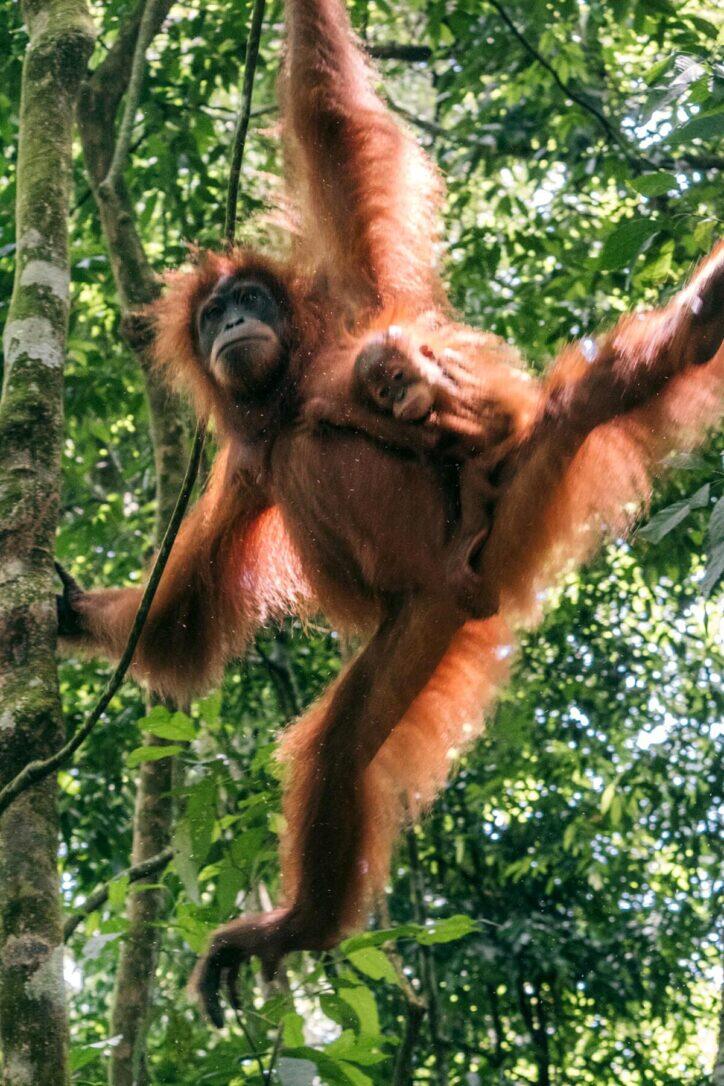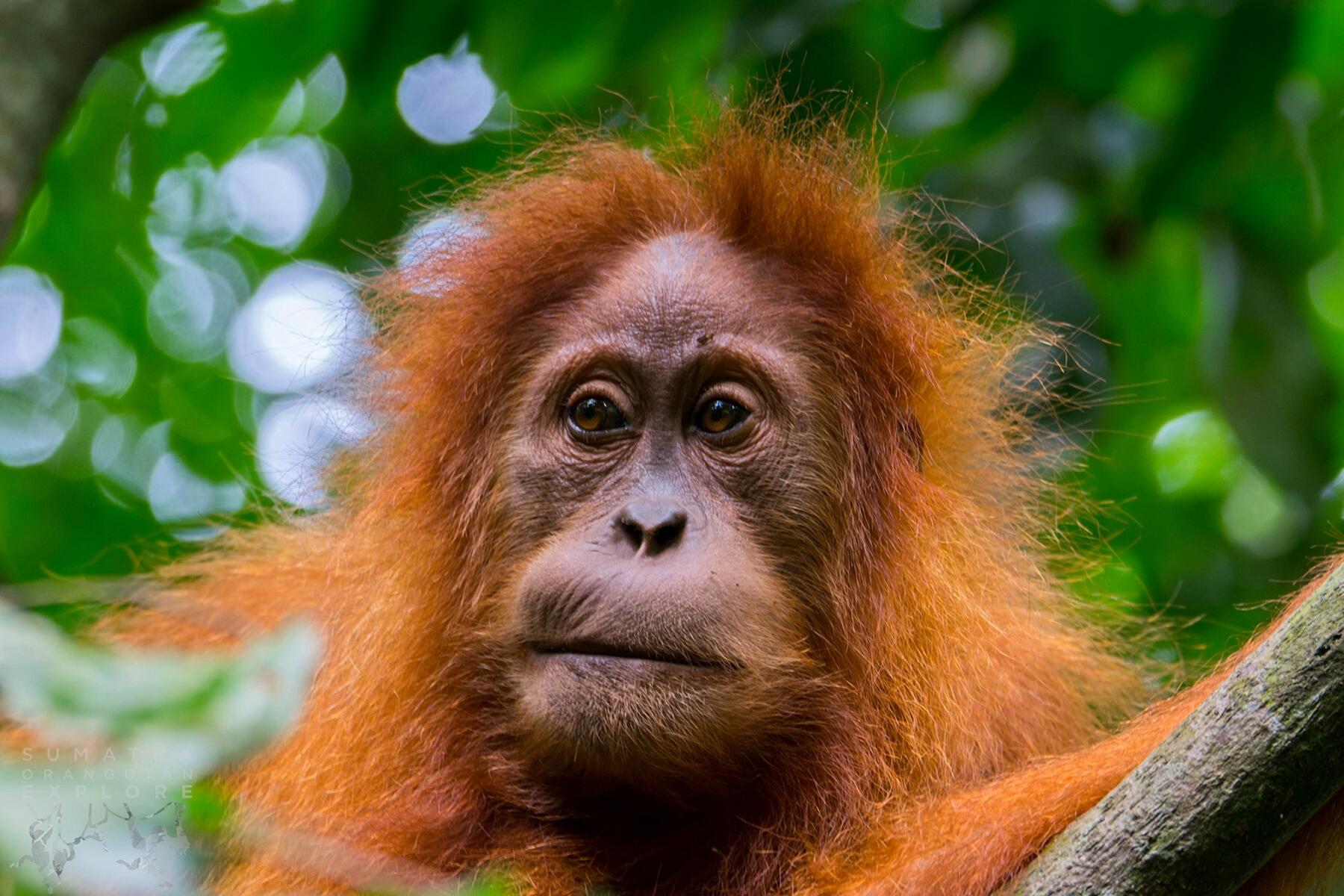With the flame-colored primates' numbers dwindling, here's how to responsibly jungle-trek to see them.
I
was drenched in sweat. Hours of trekking beneath the cacophony of jungle insects, surrounded by the crushing humidity of Gunung Leuser National Park in Indonesia was beginning to take its toll. My guide’s eyes never left the canopy as he expertly chose the least muddy path along the hillside. It seemed every time I turned my face skyward to detect a hint of orange hair amongst the dense tapestry of green above me, I ended up stumbling, or worse, with a thick black leech attached to my hip.
But suddenly, we stop. While crouching on a steep embankment, desperately trying to discern even a hint of orangutan, a mother and her three-year-old infant glide effortlessly down through the treetops to get a closer look at us. Only 20 feet of air separate us, but the pair seemed unconcerned, equally curious about us as we are them.

Locating a wild orangutan in a sea of nearly 800,000 acres of rich tropical rainforest is a monumental task. Impossible without the aid of locals, the national park guides, who know each primate by name and personality. The big cheek-padder (dominant male) likes his space, while Meena, a charismatic ape, is obsessed with the white skin of foreigners. If our paths were to cross, we would have to make our escape before she tries to take her new porcelain friends into the trees with her.
Recommended Fodor’s Video
This is one of two places on earth that you can still see orangutans in the wild. It’s the last stand for the Sumatran Orangutan. And ethical tourism can help to protect the rainforest these elusive mammals rely on to survive. Here’s what you need to know about Sumatra and how to choose an organization that puts the conservation of orangutans first.
Sumatra, Indonesia: Home to the People of the Forest
The island of Sumatra used to be a bustling tourist destination, but it’s since fallen off the beaten path. Before Bali became a tourist hub complete with an international airport, backpackers had to island-hop across Indonesia, traversing Sumatra and Java along the way. Money-flowed into the region via tourism and visitors to the Orangutan Rehabilitation Center stationed in the Bukit Lawang Orangutan Sanctuary. From the sprawling culinary melting pot of Medan to the midnight blue waters of Lake Toba, Sumatra had more than jungles to offer prospective tourists. And it still does.
But today, visitors to the rainforest will find the Orangutan Rehabilitation Center is closed. Orangutans, literally translated in Indonesian to “people of the forest”, now survive without human intervention. Travelers in Bukit Lawang now choose between the many eco-tourism agencies offering rainforest trekking to see the orangutans in their homeland. Supporting these eco-lodges, in turn, funds the conservation of the last 6,500 great apes that reside here and gives the Indonesian government a financial incentive to preserve the jungle from being sold piecemeal and deforested by palm oil plantations.
How to Find an Ethical Trekking Company in Bukit Lawang
Not all trekking companies in Bukit Lawang are created equal. Some are guilty of greenwashing and masquerading as an eco-tourism option while others blatantly disregard ethical standards. These are the key “jungle guidelines” an organization must follow to be considered an ethical and sustainable organization geared at conserving the jungle and the apes within.
1. Small Trek Groups. Typically no more than six individuals per tour. A way to limit the literal human footprint.
2. Don’t Touch the Wildlife.
3. Don’t Trek While Sick. Since we share 97% of our DNA with orangutans, they can catch all our diseases.
4. Do Not Feed the Wildlife. This includes leaving behind lunch scraps.
5. Leave No Trace. Only trek with organizations that adhere to a strict leave no trace policy.
6. Keep Your Distance from Orangutans. The orangutan’s comfort should be the main priority of the eco-lodge. Not your photo-op.
7. Locally-Owned. Supporting local small businesses helps contribute money to the local economy.
8. Only Hires Local ITGA-HPI Certified Guides. These guides have grown up in the surrounding area and know the landscape like the back of their hand. They also have been expertly trained to preserve and protect the jungle environment.
Sumatra Orangutan Explore, the eco-lodge I chose, comes highly recommended in the community. Not only do they follow the above guidelines, but they also donate 15% of the proceeds to local charities, are 97% plastic-free, offer treks suitable to travelers of all dietary restrictions and budgets, and have a supremely beautiful lodge located right on the river in Bukit Lawang.
“Since the launch of our ethical trekking company, we are committed to preserving the rainforest and protecting its amazing wildlife while benefiting the local people. Thanks to these ethical jungle rules we aim to promote wildlife ecotourism. We are committed to having a low impact on the rainforest and protecting the wildlife, especially the endangered Sumatran Orangutans, which are so sensitive to human germs and human activities.”
– Sumatra Orangutan Explore, Iman and Marie
Their most immersive treks are longer, three days or more, allowing visitors to travel deeper into the national park at a slower pace and see more orangutans and hopefully other elusive wildlife, like Sumatran elephants or sun-bears.

What to Expect on a Trek in Gunung Leuser National Park
After a bone-rattling bus ride down pot-holed roads to the small riverside town of Bukit Lawang, you’ll get to live in relative luxury. Log-cabin lodges sit pressed up against the aquamarine river banks looking out on the impenetrable wall of green jungle on the other side. Wi-fi, and sometimes even electricity in Bukit Lawang can be spotty, but surrounded by serene nature, this is the perfect destination to disconnect.
After a night or two of relishing the spicy local cuisine (beef rendang and fried potato cakes) at your lodge, you’ll be rested and ready to trek. Your local guides will lead you across the river on the suspension bridge and into the rainforest. From here, you’ll trek up to eight miles per day through undulating terrain searching for orangutans, sun-bears, Sumatran elephants, or one of the seven other primates in this rainforest. If you choose to stay overnight in the jungle, or for the recommended three nights, you’ll camp in ready-made tents with roll-out floor mats near a river to soak your aching muscles in. You’ll drink tea with biscuits, play cards by candlelight with your fellow trekkers or guides, and be stuffed with heaps of local cuisine to fuel your journey.
The return trip to Bukit Lawang, however, won’t be a strenuous jungle hike but a relaxing river ride on an inner tube raft to your jungle lodge’s doorstep. A welcome relief to the sweltering rainforest heat.
Although you’re not guaranteed to see any wildlife on your excursion (they are wild, after all) with well-trained and knowledgeable guides the odds are in your favor. On my Gunung Leuser National Park two-day trek, I saw five individual orangutans and five other species of primates. That’s not to mention the array of insects and jungle birds we happened upon.

This isn’t a bucket list journey that breaks the bank either. Many eco-lodges in the area, like Sumatra Orangutan Explore, have treks starting at $50/day and budget-friendly basic rooms starting at $7.50/ night.
If wild orangutan viewing is on your bucket list, make sure you choose responsible ways to see the last of the remaining.



